| 22 February |
• yesterday • tomorrow |
| Feast of The Chair of Saint Peter the Apostle |
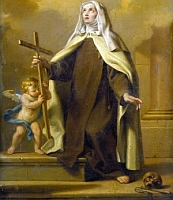
Farmer's daughter. Her mother died when Margaret was seven years old, and her step-mother considered the girl a nuisance. Margaret eloped with a young nobleman from Montepulciano, bore him a son, and lived as his mistress for nine years. In 1274 he was murdered by brigands, and his body dumped in a shallow grave.
Margaret saw the incident as a sign from God. She publicly confessed to the affair, and tried to return to her father's house; he would not accept her. She and her son took shelter with the Friars Minor at Cortona. Still young and attractive, Margaret sometimes had trouble resisting temptation, but each incident was followed by periods of deep self-loathing. To make herself unappealing to local young men, she once tried to mutilate herself, but was stopped by a friar named Giunta.
She earned her keep by tending to sick women. She later began caring for the sick poor, living on alms, asking nothing for her services. She became a Franciscan tertiary in 1277. Margaret developed an deep and intense prayer life, and was given to ecstacies during which she received messages from heaven.
In 1286 Margaret received a charter to work with the sick poor. She gathered others of like mind, and formed them into a community of tertiaries. They were later given the status of a congregation, and called the Poverelle (Poor Ones). With them she founded a hospital at Cortona. Margaret preached against vice of all sorts to any who would listen. She developed a great devotion to the Eucharist and Passion, and prophesied the date of her own death.
Though she worked for those in need, and though the poor sought her help and advice, the calumny of her earlier life followed her the rest of her days, and she was forever the target of local gossips.
1247 at Loviano, Tuscany, Italy
22 February 1297 at Cortona, Italy of natural causes
16 May 1728 by Pope Benedict XIII
• against insanity or mental illness
• against sexual temptation
• against temptations
• falsely accused people
• hoboes, tramps
• homeless people
• against the death of parents
• mentally ill people
• midwives
• penitent women
• people ridiculed for their piety
• reformed prostitutes
• single laywomen
• tertiaries
• Arezzo-Cortona-Sansepolcro, Italy, diocese of
• Cortona, Italy, diocese of
• Cortona, Italy, city of
O Saint Margaret of Cortona, I too come today as a pilgrim and I pause to pray with you at the feet of the image of Christ Crucified and Risen, whom, as a penitent, you contemplated at length. Lord Jesus, crucified for us, in offering yourself on Calvary for all humanity, you have revealed to us the wellsprings of everlasting life. May the mystery of your Passion enlighten our life making us ready to follow you on the way of holiness and love. Rekindle our faith; teach us to recognize and welcome in our everyday life the plans of your mysterious Providence. Give us the courage to confess our sins and open our hearts to sorrow, in order to receive the gift of your mercy. Empower us to forgive our brethren following the example of your love that knows no bounds. Help us to be humbly disposed to repair the harm we have done by actively and generously serving the poor, the sick, and all who are marginalized and without hope. Give everyone the joy of persevering faithfully, in full harmony with the Church, along the way of the particular calling. Above all others, show the young the splendid plan of love that you intend to bring about for them and with them at the threshold of the new millennium. Enable us to be peacemakers, tenacious weavers of daily relationships of fraternal solidarity, artisans of reconciliation, witnesses and apostles of the civilization of love. O glorious Saint Margaret of Cortona, present this request to your Crucified Lord and ours. Guide us with the strength of your example, support us with your constant protection, be our companion we beg you, till we reach our Father's house. Amen. - Pope John Paul II, 1999
https://catholicsaints.info/saint-margaret-of-cortona/
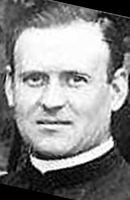
One of eight children in the family of a stone mason. His mother taught the children religion, and would sprinkle them with holy water each night before bed. Attracted to the idea of mission work, Richard joined the Pallotines in 1919. Spiritual student of the Servant of God Joseph Kentenich. Ordained to the priesthood on 6 June 1925 in the diocese of Limburg, Germany. Teacher in several Pallottine and Schoenstatt schools beginning in 1926. In 1927 he diagnosed with tuburculosis, and collapsed from exhaustion; there was thought to transfer him to South Africa for his health, but he was considered too sick to surive such a trip. By 1928 he was somewhat recovered, and insisted on resuming teaching. In 1931 he was assigned to schools in Upper Silesia.
A skilled and popular preacher and retreat leader, Richard was known for condemning the ideology and actions of the Nazis, especially the murder of disabled people and others considered an unproductive burden on society. He was arrested for this on 7 March 1937 in Roppach, Germany, but was warned and released. Father Richard became an indirect collaborator with the Resistance, and spoke so forcefully and so often against the Nazis that his superiors began to worry that the Nazis would retaliate against the school where Richard taught. He was arrested again on 8 April 1943 in Branitz, Germany for making political statements, and was imprisoned first at Ratibor, Germany, and then in the Dachau concentration camp where he was forced to do manual labour for the SS, and where he would remain the rest of his life. He became friends with fellow prisoner and future Cardinal, Josef Beran, who taught Father Richard the Czech language so he could help minister to imprisoned Czechs. When typhoid broke out in the camp, Father Richard volunteer to minister to the sick until he contracted the illness himself. Martyr.
26 May 1900 in Ruppach, diocese of Limburg, Westerwald, Germany
• 22 February 1945 in cell block 17 of the Dachau concentration camp, Germany of typhoid he had contracted while caring for fellow prisoners
• body cremated
• ashes smuggled out of the camp and given Christian burial in Limburg, Germany on 7 June 1945
• ashes re-interred in Limburg in 1990
• 15 September 2019 by Pope Francis
• the beatification recognition was celebrated at the Cathedral of Sankt–Georg in Limburg, Germany with Cardinal Kurt Koch as chief celebrant
https://catholicsaints.info/blessed-richard-henkes/
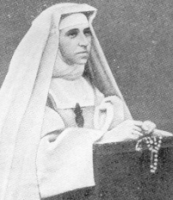
• Émilie d'Oultremont van der Linden d'Hooghvorst
• Marie of Jesus
• Mary of Jesus
Born to the nobility, the daughter of Count d'Emile Oultremont de Wégimont a de Warfusée, a diplomat who represented King Leopold I to the Vatican. From childhood émilie had a great devotion to the Eucharist and the Sacred Heart of Jesus; she later developed a great admiration of Saint Ignatius of Loyola. Married to Victor van der Linden, Baron d'Hooghvorst in 1837. Mother of two boys and two girls. She sought out Jesuits for spiritual guidance. Widowed in 1847. When her sons entered college in France, she decided to move, too.
On 8 December 1854, the day the dogma of Mary's Immaculate Conception was proclaimed, émilie experienced a profound spiritual experience and announced she was going into religious life. With a small group of young women, she founded the Institutum a Maria Reparatrice (Sisters of Mary Reparatrix) on 1 May 1857 in Strasbourg, France. On 2 May 1858 Emilie made her vows, taking the name Mary of Jesus. Soon after her daughters joined the Sisters, which caused even more turmoil in her family; few had supported her entering religious life, and many complained that the girls had followed only for her mother's sake.
In 1859 Mother Marie received a request for help from Jesuit missionaries in Madras, India. The Sisters expanded to India in 1860, England in 1862, Belgium in 1863, Mauritius in 1866, France, Italy, Ireland, Spain, and then Jerusalem in 1888. The mother house was relocated from Strasbourg to Rome, Italy.
11 October 1818 in Wegimont near Liège, Belgium
• 22 February 1878 at the home of her son Adrien in Florence, Italy of natural causes
• buried in the church of Saint Bonaventure in Rome, Italy
12 October 1997 by Pope John Paul II
https://catholicsaints.info/blessed-emilie-doultremont-dhoogvorst/
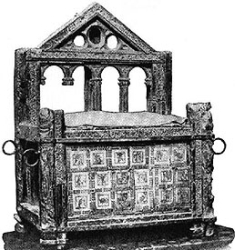
The feast of the Chair of Saint Peter in general about the formation of the Church when Christ said, “You are Peter and on this rock I will build my Church.” It has been celebrated at Rome, Italy from the early days of the Christian era on 18 January, in commemoration of the day when Saint Peter held his first service in Rome. The feast of the Chair of Saint Peter at Antioch, commemorating his foundation of the See of Antioch, has also been long celebrated at Rome, on 22 February. At each place a chair (cathedra) was venerated which the Apostle had used while presiding at Mass. One of the chairs is referred to about 600 by an Abbot Johannes who had been commissioned by Pope Gregory the Great to collect in oil from the lamps which burned at the graves of the Roman martyrs. One of these phials, preserved in the cathedral treasury of Monza, Italy, had a label reading, "oleo de sede ubi prius sedit sanctus Petrus" (oils from the chair where Saint Peter first sat). The Mass for both feast days is the same; the Collect is as follows:
"Oh, God, who, together with the power of the keys of the kingdom of heaven, didst bestow on blessed Peter Thy Apostle the pontificate of binding and loosing, grant that by the aid of his intercession we may be released from the yoke of our sins."
The image is a portable chair preserved at the Vatican and believed to be a chair used by Saint Peter, the extant testimony referring to it dating from the 2nd century.
He who deserts the chair of Peter, upon whom the Church was founded, does he trust himself to be in the Church? - Saint Cyprian, Bishop of Carthage and Martyr, De Catholicae Ecclesiae Unitate, 251
https://catholicsaints.info/chair-of-peter/

Isabel of France
• 31 August (Franciscans)
• 8 November as one of the Saints of the Diocese of Evry
Born a princess, the daughter of King Louis VIII of France and Blanche of Castile; sister of Saint Louis IX; aunt of Saint Louis of Tolouse. Declined a marriage offer from the German emperor in order to found a Poor Clare convent at Longchamps near Paris, France where she lived as a nun, though without taking vows. Circa 1259, Pope Alexander IV approved a Rule Isabella had written for what became the Order of the Humble Handmaidens of the Blessed Virgin Mary.
March 1225
• 22 February 1270 at the abbey of Longchamp, France of natural causes
• buried at the abbey in Longchamp
• exhumed after nine days and found incorrupt
• exhumed in 4 June 1637
1521 by Pope Leo X (cultus confirmation)
sick people
crown at her feet
https://catholicsaints.info/blessed-isabella-of-france/

Maximianus
Bishop of Ravenna, Italy in 546 by Pope Vigilius with the support of Emperor Justinian; the choice was initially so unpopular that the Maximian had to live outside the city walls for a while. Built the basilica of Saint Vitalis, and either built or renovated many other churches. Commissioned a number of illuminated manuscripts, and made sure that the text were updated with the most authoritative versions. May have been the first Latin bishop to use the title archbishop.
499 in Pola, Istria (modern Pula, Croatia)
556 of natural causes
• bishop holding a jewelled cross
• bishop with Emperor Justinian
https://catholicsaints.info/saint-maximian-of-ravenna/
1 February as one of the 109 Spanish Claretian Martyrs
Member of the Claretians, professed on 24 March 1893. Martyred in the Spanish Civil War.
22 February 1861 in Perarrua, Huesca, Spain
shot on 22 February 1937 in at Caseta de Alboquers, Barcelona, Spain
• 21 October 2017 by Pope Francis
• beatification celebrated at the Basilica of Sagrada Familia, Barcelona, Spain, presided by Archbishop Angelo Amato
https://catholicsaints.info/blessed-miguel-facerias-garces/
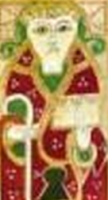
Papia di Gerapoli
Second century Apostolic Father. Friend of Saint Polycarp of Smyrna. Bishop of Hierapolis, Phrygia (in modern Turkey). Author of lengthy commentaries on the life, teaching, and works of Jesus; they survive only in fragments.
early 2nd century
https://catholicsaints.info/saint-papias-of-hierapolis/
Fifth-century cave hermit near Cyrrhus (in modern Syria). Spiritual student of Saint Thalassius. Spiritual student of Saint Maro. Lived in a small stone hut on a hill top, and talked to would-be students through a small hole; they came so frequently that he built a house on the hill top for them to stay. A noted healer, he built two houses for the blind, and induced any would-be spiritual students to contribute to care for the poor and lame.
https://catholicsaints.info/saint-limnaeus/
Monk in France. Invited by King Alfred of England to restore faith and learning to the English abbeys ravaged by the Danes. Abbot of Athelingay. Murdered in a church at night by two French monks who were under his guidance, but rebelled against it. Considered a martyr as his death was caused by working for the Faith.
in Saxony (part of modern Germany)
895
https://catholicsaints.info/saint-john-the-saxon/
Born wealthy, he preferred the life of a poor hermit. Monk and then abbot at the monastery of Saints Peter and Paul near Nicomedia, Bithynia (modern Izmit, Turkey). Flogged, imprisoned and exiled during the iconoclastic persecutions of Emperor Leo V. Supported Saint Theodore Studites.
Constantinople
c.818
https://catholicsaints.info/saint-athanasius-of-nicomedia/
Baradatas, Baradatus
Hermit in a tiny shack in Cyrrhus, Syria; he wore animal skins, lived on whatever came to hand, and spent every possible moment in prayer. Emperor Leo I of Constantinople wrote to Baradates for his thoughts on the Council of Chalcedon in 451.
c.460
https://catholicsaints.info/saint-baradates-of-cyrrhus/
Didacus, James
Jesuit priest. Missionary to Japan. Martyred with 60 companions by being exposed to the cold for days.
c.1578 in Coimbra, Portugal
martyred by exposure on 22 February 1624 at Sendai, Miyagi, Japan
7 May 1867 by Pope Blessed Pius IX
https://catholicsaints.info/blessed-diego-carvalho/
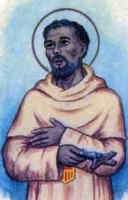
Mercedarian friar at the convent of San Lazzaro in Zaragoza, Spain. Known for his personal piety and outlook that saw the hand of God in all things.
African
https://catholicsaints.info/blessed-mohammed-abdalla/
Angelo
Dominican. Bishop of Iglesias, Sardinia, Italy in 1330.
c.1296 in Perugia, Italy
1334 on Ischia, Naples, Italy
https://catholicsaints.info/blessed-angelus-portasole/
Abilio, Abitius, Abylius, Avilio, Avilius, Melyos, Mielo, Milius, Sabellius
Third bishop of Alexandria, Egypt c.84.
c.98
https://catholicsaints.info/saint-abilius-of-alexandria/
Ariston
Fifth century bishop of Arsinoe on the island of Cyprus.
4th century
5th century
https://catholicsaints.info/saint-aristone-of-arsinoe/
A memorial for all the unnamed Christians martyred in the desert and mountainous areas south of the Dead Sea during the persecutions of Emperor Valerius Maximianus Galerius.
https://catholicsaints.info/martyrs-of-arabia/
Paschase, Pascase, Pascasio
Bishop of early 4th-century Vienne, France.
312
https://catholicsaints.info/saint-paschasius-of-vienne/
One of Jesus's 72 disciples. Preached in Cyprus. Martyr.
martyred in the Battle of Salamis in Cyprus
https://catholicsaints.info/saint-aristion-of-salamis/
Raynier
Monk at Beaulieu Abbey near Limoges, France.
c.967
https://catholicsaints.info/saint-raynerius-of-beaulieu/
Gurmin, Gurminn
Irish nun. She is mentioned in the Tallagh and Donegal martyrologies, but no details of her life have survived.
https://catholicsaints.info/saint-gurnin/
Fifth-century cave hermit near Cyrrhus (in modern Syria). Spiritual teacher of Saint limnaeus. Known for his personal piety and holiness.
https://catholicsaints.info/saint-thalassius/
Allan, Alleyn, Elwyn
Missionary who worked with Saint Breaca in Cornwall.
Ireland
https://catholicsaints.info/saint-elwin/
CatholicSaints.Info Portable Edition